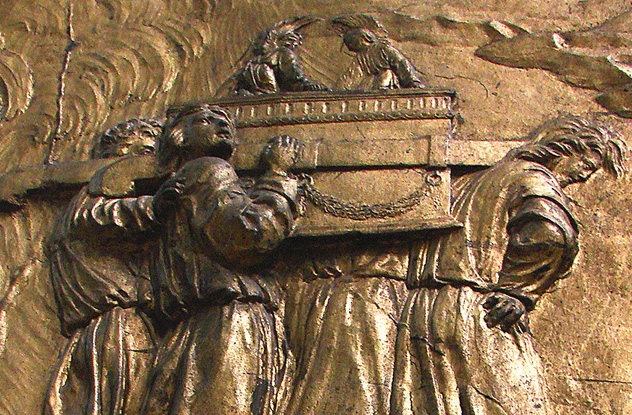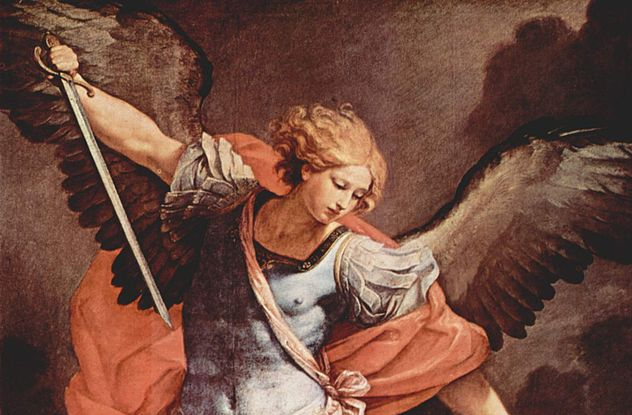 Mysteries
Mysteries  Mysteries
Mysteries  History
History 10 Surprising Stories About the Texas Rangers
 Humans
Humans 10 Philosophers Who Were Driven Mad by Their Own Theories
 Miscellaneous
Miscellaneous 10 Video-Game-Worthy Weapons and Armors from History
 Weird Stuff
Weird Stuff 10 Psychics Who Accurately Predicted Wartime Events
 The Arts
The Arts 10 Pieces of Art Inspired by a Broken Heart
 Health
Health 10 Science Fiction-Sounding New Medical Treatments
 History
History 10 Surprising Facts About the Father of Submarine Warfare
 Space
Space Ten Astonishing New Insights into Alien Worlds
 Weird Stuff
Weird Stuff 10 Bizarre Summer Solstice Rituals Still Practiced Today
 Mysteries
Mysteries Top 10 Haunting Facts About the Ghost Ship MV Alta
 History
History 10 Surprising Stories About the Texas Rangers
 Humans
Humans 10 Philosophers Who Were Driven Mad by Their Own Theories
Who's Behind Listverse?

Jamie Frater
Head Editor
Jamie founded Listverse due to an insatiable desire to share fascinating, obscure, and bizarre facts. He has been a guest speaker on numerous national radio and television stations and is a five time published author.
More About Us Miscellaneous
Miscellaneous 10 Video-Game-Worthy Weapons and Armors from History
 Weird Stuff
Weird Stuff 10 Psychics Who Accurately Predicted Wartime Events
 The Arts
The Arts 10 Pieces of Art Inspired by a Broken Heart
 Health
Health 10 Science Fiction-Sounding New Medical Treatments
 History
History 10 Surprising Facts About the Father of Submarine Warfare
 Space
Space Ten Astonishing New Insights into Alien Worlds
 Weird Stuff
Weird Stuff 10 Bizarre Summer Solstice Rituals Still Practiced Today
10 Things Everyone Gets Wrong About Angels
Angels are mentioned numerous times throughout the Bible, always present during monumental, epic events. They’ve also been prominently featured in artwork for centuries, from the adorable little cherubs that float through Renaissance paintings to the winged, weeping angels that stand guard in cemeteries. Yet, much like with fallen angel Satan, much of our beliefs about what angels are and what they look like are pretty wrong—according to the Bible.
10You Don’t Get Your Own Guardian Angel

We’ve all heard the stories about the people saved by a mysterious stranger or who feel that they’re being watched over by an otherworldly entity. It’s comforting that someone who knows more than we do is out there to put us on the right path. But nothing in the Bible says that we each have our own guardian angel.
A few passages do talk about angels in a guardian role. One is Matthew 18:10, which states, “See that you do not despise one of these little ones. For I tell you that in heaven their angels always see the face of my Father who is in heaven.” It’s often interpreted that it’s a reference to angels who look out only for children or for all faithful believers as a whole, but nothing suggests that everyone gets their own.
The idea of guardian angels for each individual is a fairly recent one and the product of a slow evolution of stories. Throughout the Middle Ages, stories were told of saints who had encounters with angels or were protected by them. These evolved into stories where angels came to the rescue of the everyday person, commonly told throughout the 18th and 19th centuries. By the time the 20th century came around, we were telling stories of the guardian angel who followed each person around and protected them from harm.
9Cherubs Aren’t Baby-Faced Angels

Cherubs are one of the most commonly depicted types of angels in art, and we all know what they look like. They’re little naked babies, adorable, chubby, and winged. But that’s just a fairly recent invention of artists, and the biblical cherubs were much stranger.
The cherub is a very specific type of angel. They’re the ones closest to God, serving directly under Him rather than being a messenger to mankind. They pop up pretty regularly in the Old Testament, and when they do, they’re decided un-adorable.
According to Genesis, two cherubs were assigned to guard the tree of life. In Ezekiel 1:5–11, we get a full description of these guardians. According to the scripture, the cherubs have an overall human form but their legs end in the hooves of a calf. They have four wings that hide their human hands and four faces. When they move, the faces never turn. The front face is that of a man, the right face is a lion, the left a bull (or ox), and the rear face is that of an eagle.
Each cherub glows as though on fire, and Ezekiel further describes them as serving as something of a living, sentient chariot for God. In his vision, God rides in a chariot with cherubs serving as the wheels. Four cherubs stand together, representing the strength of the lion, the freedom of the eagle, the weight and girth of the bull, and the wisdom of man—God’s greatest achievements, all rulers of their respective realms. Each cherub covers its body with one pair of wings and stretches the other pair overhead. The wings were covered in eyes.
That’s about as far away from cute little naked babies as you can get.
8Cherubs Aren’t Necessarily Pleasant, Either

In art, cherubs are adorable, always smiling, flapping their wings, and usually playing a harp. Biblical cherubs aren’t so cheery. Consider, for example, the Mercy Seat, the lid of the Ark of the Covenant. It’s pretty well known thanks to Indiana Jones, and it’s pretty dark.
The two figures on the Mercy Seat are cherubs, their faces and bodies hidden in one set of wings. The other set are outstretched toward each other. They form a throne, and according to scripture, that seat signifies the potentially lethal presence of a wrathful God. Every year, a High Priest performed a ceremony, sprinkling the blood of animal sacrifices on the Mercy Seat to appease God and hold off His wrath for another year.
Another specific ritual had to be undertaken to safely approach the Mercy Seat. Any deviation from the ritual was said to be deadly for the priest foolish enough to disrespect it. Every year, the cherubs would receive the blood offering of animal sacrifices, until it was no longer necessary. Once Christ was crucified, that blood sacrifice was enough to forever satisfy the cherubs.
7People Don’t Become Angels

It’s a famous movie trope, but nothing in the Bible suggests that the good and righteous become angels when they die. A couple passages even suggest that it’s impossible.
Angels and humans are both said to have been created by God, but they serve very different purposes. Hebrews 1:14 says specifically that angels were created to lend a helping hand to those that believe in God, and Genesis 1:26 states that angels are spiritual beings who can only take a human-like form at God’s will.
The book of Peter suggests that angels are absolutely not made from the souls of the righteous. It says, “It was revealed to them that they were not serving themselves, but you, in these things which now have been announced to you through those who preached the gospel to you by the Holy Spirit sent from heaven—things into which angels long to look.” If the Holy Spirit preaches to mankind, and angels wish they could hear the same message, those angels weren’t once human.
6Angels Aren’t Male And Female

Countless paintings show male angels appearing to people in biblical scenes, while graveyard statuary often show female angels mourning over graves. Yet nothing in the Bible indicates such a thing as female angels.
Angels aren’t human, and they’re not bound by the same biological constraints that humans are. It can be argued that there’s no such thing as sex when it comes to angels. But all angels throughout the Bible are referred to in the masculine sense—in fact, the Greek word angelos, used throughout the New Testament, is a masculine word that doesn’t even have a feminine form.
Only two of God’s angels are named—Michael and Gabriel—and the others are always referred to as “he.” The single time that female winged creatures are mentioned in the Bible is in Zechariah 5:9; the women are presented in the context of a series of visions that include a flying scroll, and nothing suggests they’re angels.
The idea of female angels came centuries after the Bible. There’s no known artistic representations of angels until around the fourth century, as Christianity tried to distance itself from other religions’ worship of images and idols. Once art did start being created, angels perhaps melded with winged creatures from other mythologies—such as Nike and some of the other pagan goddesses.
5Angels Have No Halos

Conjure up a mental image of a biblical angel, and it likely has long, flowing robes, wings, and a halo. But when described in the Bible, angels never were mentioned as having a halo—and nor was anyone else. The closest references to anything even remotely like the halo that’s become the staple of religious artwork is the reference to a glow of light surrounding a few select characters—Christ and Moses.
That glow in religious paintings is more accurately called a “nimbus.” It first showed up in fourth-century art, initially only used in works showing Christ sitting on a throne. It gained popularity as a way to signify goodness and was next extended to all depictions of Christ and to angels. By the sixth century, everyone was wearing them—including the figures of saints.
The halo or nimbus is one of those things that Christianity didn’t so much invent as adopt. The idea dates back to ancient kings from Syria and Egypt, who would wear halo-like crowns to signify their connection with their deities and the surrounding divine light. Ancient Rome was fond of using the rays and crown in their depictions of their emperors. Christian artists just picked up the well-established symbol and ran with it.
4They Don’t Have Two Wings, Either

Much like the depiction of angels with halos, this image is more a product of later artists than actual biblical texts.
Wings aren’t a big part of any of the angelic stories in the Bible, although they’re often mentioned as “flying”—which is understandably interpreted as having wings. The Seraphim, one of the highest ranks of angels, who stand before God and quite literally burn with love for their Lord (and inspire others to do the same), are specifically described in Isaiah as having six wings. Only two were used to fly, while another pair were used to cover the angel’s face and the third pair covered the angel’s feet. Cherubs are usually described as having four wings.
Early Christian art that depicted angels usually omitted wings. Some of the earliest examples of winged angels are on Roman sarcophagi; the sarcophagus of the Roman politician Junius Bassus depicts the famous biblical scene of an angel appearing to Abraham and telling him not to sacrifice his son. The angel in the scene is without wings, but other figures on the sarcophagus do have wings, suggesting that the time it was carved—around A.D. 359—saw a general shift in the perceptions about what angels look like. By the end of the century, angels were firmly associated with the appearance of winged pagan gods and goddesses.
3There Is No Christian Angel Of Death

The Angel of Death is a powerful image, a darkly beautiful creature whose only role is to destroy life. A few passages in the Bible—such as the Passover story in Exodus 11:4–5 and 2 Kings 19:35—speak of angels taking human life. In fact, in Kings, the angel takes the lives of 185,000 Assyrians. However, the traditional Angel of Death is just that—death. The angels who kill in the Bible aren’t solely dedicated to the task of destroying human life. They’re just carrying out orders from God and are very forceful messengers.
Similarly, Jewish tradition rejected the idea of an Angel of Death. Only God, not angels, has the power of life and death. Eventually, though, the idea of an Angel of Death seeped into official religious canon. The Angel of Death became known as Samael, one of the angels first mentioned in a rather unimportant and easily overlooked reference. During the Amoraim period of scholarly history (A.D. 220–370), Samael as the Angel of Death merged with other references. The original texts mentioned angels turning into vengeful, death-bringing messengers, and Samael was gradually given the mantle of the Angel of Death.
Samael made the jump from religious canon to folklore, soon becoming an independently thinking creature. He wasn’t fulfilling God’s wishes anymore. He was hunting and killing on his own. This folklore-ish Samael was covered with eyes to ensure that he didn’t miss anything. In Jewish tradition, he’s occasionally linked with Cain and is said to have brought the power and desire to kill to mankind.
2Gabriel Is One Of The Lowest-Ranking Angels

Gabriel appears in the Bible four times, and one of those times is repeated every Christmas and cements his popularity. He appears to Mary and tells her that she has been selected to bear the Son of God; he also appears a couple of other times, acting as a messenger. He’s defined as an archangel as opposed to just a regular old angel, and it seems like that’s an important distinction.
Being an archangel does mean that you rank above an angel, but there are other angelic beings above you. In fact, there are many.
Angels are described as having a distinct, three-tiered hierarchy, and within each tier are three sub-groups. The first hierarchy, closest to God, includes the Seraphim (that are the closest of all to God), the Cherubim, and the Thrones, which are said to be inseparable from the word of God. In the second tier, we have the Dominions who governs the rest and help humans control their urges, the Virtues who are in charge of sending miracles, and the Powers who help protect good people from the temptations of the devil.
And in the last hierarchy, the lowest group and the farthest from God, the Principalities are at the top. They’re said to control the other angels below them. The different earthly kingdoms have their own Principalities, which are responsible for overseeing and managing groups, making sure that worthy people are raised to leadership, and helping ensure that power is wielded for the name of God. Directly beneath them are the archangels, who serve as God’s messengers, as we see in the appearances of Gabriel. Below the archangels are the angels, who appear among mankind more often, relay news of minor miracles, and are there to lend a helping hand if needed.
The farther down the hierarchy you are, the farther from God you are. That makes Gabriel, one of the only named angels in the Bible and the poster child for manger scenes everywhere, lower than middle management.
1Angels’ Evil Brought About the Flood

Angels are almost always thought about in the context of being messengers and servants of God. Even when they’re killing, they’re carrying out God’s will. But according to one interpretation, angels are at least partly to blame for the biblical flood that wiped out all of mankind (except for Noah and his family).
According to Genesis, in the days before the flood, Earth was home to mankind as well as a race called the Nephilim. The Nephilim were born from the “sons of God” and the “daughters of Man,” and one of the common interpretations of this is that the “sons of God” were angels who came to the earthly realm and gave in to the pleasures they found there. Jude 1:6 refers to those who had left their rightful abode and gone to Earth, while Genesis itself presents the Nephilim as the offspring of human women and divine creatures.
While the interpretation is a bit up for debate in Christian realms, it’s a little more straightforward in Jewish theology. When God sees the corruption that has taken hold of his creation, Azael and Samhazai volunteer to go to Earth and prove that man is responsible for his own destiny. While they’re there, they not only give in to the earthly pleasures they’re trying to avoid but Samhazai breaks one of the most sacred of his oaths—he gives God’s true name to a mortal woman. He is never allowed back into heaven, and Istar, the woman, is raised to heaven and placed among the stars. He repents, but this just gets him to limbo between Earth and heaven. Other versions say as many as 18 angels mingled with women and produced offspring.
In both traditions, the presence of worldly sin, along with the Nephilim, causes God to destroy all that he has created—including the giant Nephilim, offspring of his beloved angels.








